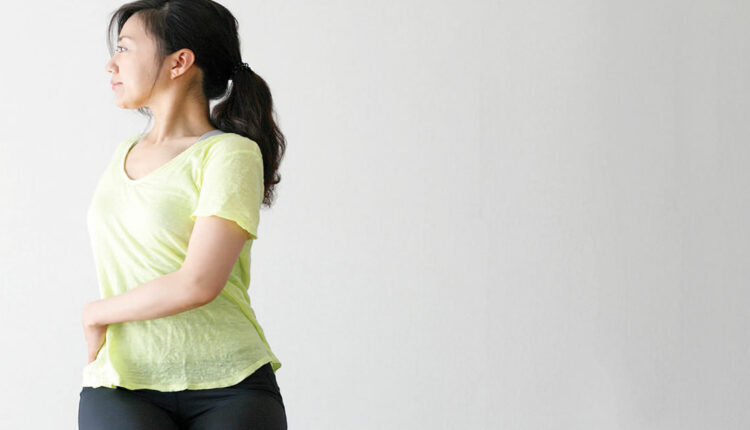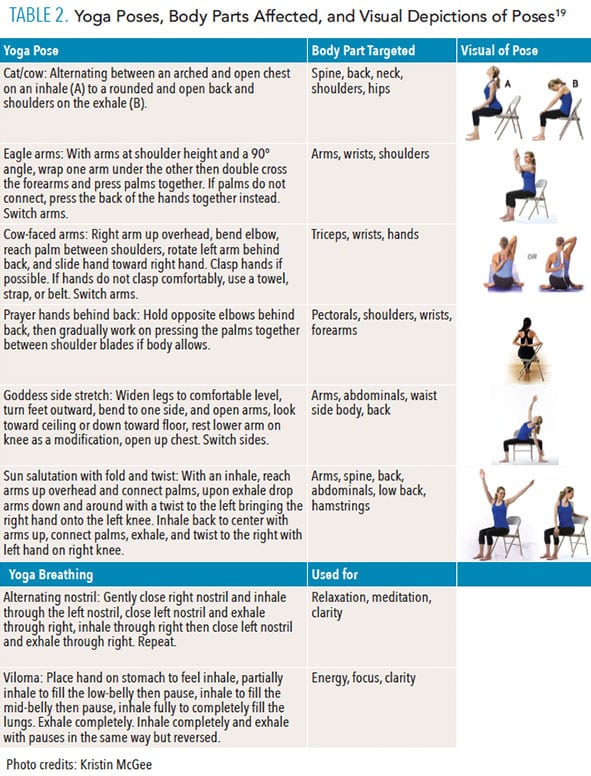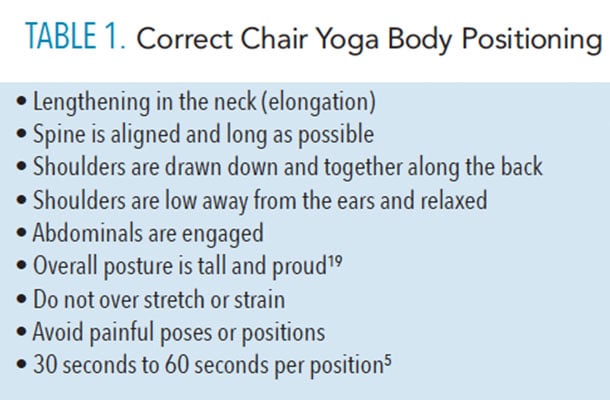 BEE32/ISTOCK/GETTY IMAGES PLUS
BEE32/ISTOCK/GETTY IMAGES PLUS
An Addition to the Ergonomic Toolbox
Chair yoga can help oral health professionals reduce their risk of musculoskeletal disorders and pain, as well as prevent work burnout.
Working in dental hygiene is immensely rewarding, and oral health professionals have a high level of job satisfaction.1 However, due to the physical and mental demands of clinical work, the occupational risks for musculoskeletal disorders (MSDs), musculoskeletal pain, and mental stress are high.2–7 In addition to maintaining proper ergonomics, chair yoga performed at the dental office is a natural and easy daily practice to combat the pain and stress associated with providing dental hygiene care.2,3
OCCUPATIONAL RISKS
Precision and focus are necessary for high productivity and performance as oral health professionals strive to deliver high-quality dental care. Clinicians are at increased risk for developing MSDs due to extended periods of static, awkward posture and repeated intricate movements for long hours.5 MSDs develop with repeated strain of muscles, nerves, blood vessels, ligaments, and tendons.8
Extensive research demonstrates that MSDs significantly impact workplace health and longevity due to these factors.2–6 Pain, tingling, numbness, or itching are all signs of a decrease in blood flow to a muscle.5 Between 62% and 96% of oral health professionals report MSDs and work-related pain; the prevalence increases proportionally to the number of years worked.2–5,9 In a survey of 877 private practice dentists, 70% (614) reported musculoskeletal pain, with lower back, shoulders, and hips being the most common sites of pain.6 A cross-sectional study found that 59 of 74 dentists (74.7%) experienced work-related pain within the past 6 months.10 In a systematic review, head, neck, and shoulder pain, followed by hand and wrist pain, were the most common sites reported by 80% of the dental hygienist participants.2
Another occupational risk is stress, which can lead to burnout.7 Stress experienced by oral health professionals is typically related to the need for intense concentration, repetitive work situations, negative interactions with patients and colleagues, time constraints, and production requirements.11 Chronic stress over time can result in increased risk for cardiovascular and inflammatory diseases, mental health issues, insomnia, and a lower quality of life.12–14
![Chair yoga body positioning]() BARRIERS TO THE PREVENTION OF OCCUPATIONAL RISKS
BARRIERS TO THE PREVENTION OF OCCUPATIONAL RISKS
Physical performance in dentistry requires sedentary periods ranging from 15 minutes to several hours. This chairside commitment limits time for movement, walking, stretching, and change in positioning. Exercise and physical activity outside of work directly correlate to reducing the risk of negative health effects.2,6,9 However, life demands may restrict the amount of time oral health professionals can commit to maintaining a healthy lifestyle.8 Monetary needs require many households to have both partners working part-time or full-time, which creates a time commitment barrier to obtaining optimal physical and mental health. Although there are many barriers to proper prevention of MSDs and stress, oral health professionals must make prevention a priority to ensure career longevity and satisfaction, and reduce occupational health risks.8 Choosing an exercise that accommodates a clinician’s needs will help establish compliance.
CHAIR YOGA
Proper ergonomics may be optimally maintained through the utilization of magnification, correct positioning of the patient and operator, and the use of an ergonomically correct chair, such as a saddle style or exercise ball.15 Maintaining proper ergonomics sets the operator up for success in musculoskeletal alignment. However, it may not be enough to reverse or prevent the physical and mental strain of dentistry.16
Yoga may improve body alignment by increasing the practitioner’s ability to maintain his or her ergonomics more ideally. Yoga has been used for centuries throughout the world to achieve a higher level of physical and mental health. During the practice of yoga, specific postures and breathing techniques are sequenced to align and energize or calm the entire body.11 Yoga is not a replacement for proper ergonomics, yet it can be an effective addition to improve the mind and body.
Chair yoga can be done using the operator stool quickly in-between patients, on a lunch break, before or after work, alone, or in a staff meeting. In as little as 30 seconds to 60 seconds, stretching a muscle can increase blood flow and range of motion, relieve pain, and improve musculature.3,5,11 Koneru and Tanikonda3 describe yoga as a system for healing because it releases endorphins and hormones that lower stress and strengthen the musculoskeletal system.
As a proven safe and effective activity to reduce and prevent injury, yoga has also been shown to decrease the amount of absentee days from work.5,11 A pilot study found that consistent yoga practice was preferred over other forms of exercise, and yoga may lead to career longevity, in addition to multiple physical benefits.16 When yoga was performed at work, a direct correlation was seen between upper body pain and stress reduction and yoga practice frequency.11 A study of dentists found that 89.5% experienced a reduction in pain through yoga compared with other physical activity.3 Successful stress reduction was demonstrated over a 6-week yoga practice during a randomized controlled trial in which participants were asked to provide their self-reported stress levels using validated stress-tests.17 The study authors suggested that yoga should be offered by employers to their employees.

INCORPORATING YOGA INTO A DAILY ROUTINE
Yoga can be integrated into anyone’s day with ease. The yoga breathing techniques and postures can be customized to fit oral health professionals’ needs to target site-specific pain or tightness and can be modified to address different abilities and physical conditions. Any exercise, including yoga, must be done correctly to avoid over-stretching or strain to muscles, ligaments, or tendons.5,18 Body weight must be properly dispersed to prevent injury and the use of a prop, such as a chair, can facilitate correct posture in a pose without strain.18
The philosophy of yoga is to change the pose to fit the individual. The physical formation of the yoga poses can positively affect both the physiological and mental aspects of pain and stress.16,17 In addition, the breathing and meditation techniques are designed to provide deeper levels of relaxation, energy, and clarity. Alternating nostril breathing can be used for deep long meditation or short periods of relaxation. To perform this technique, one nostril is gently compressed for one inhalation and exhalation. The alternate nostril is then compressed for another inhalation and exhalation.19 The technique of Viloma breathing offers energy and focus and consists of a series of short breaths with pauses during inhalation and exhalation.
Some key body mechanics should be considered during the practice of all yoga. Table 1 provides correct chair yoga body positioning. Table 2 includes those yoga poses suggested for oral health professionals’ most common pain sites.19
CONCLUSION
Dedication to a career in oral health comes with some occupational risks, including MSDs and chronic stress. As health care providers who devote time and attention to prevention, oral health professionals must acknowledge that they themselves need to actively pursue health maintenance to prevent injury. While there are many physical activities that reduce occupational risks, chair yoga shows promise as a safe and preferred choice. Consistency, compliance, proper body mechanics, and safe use are factors that may affect the benefits of chair yoga poses and breathing techniques. A consultation with a physician and/or a yoga professional may be necessary to ensure correct practice modifications are made, as yoga can exacerbate any existing injuries, such as carpal tunnel syndrome or tendinitis, if performed incorrectly. Making time for this type of mental and physical self-care is critical as it may contribute to career longevity and overall well-being.
REFERENCES
- Gibbons DE, Corrigan M, Newton JT. A national survey of dental hygienists: working patterns and job satisfaction. Br Dent J. 2001;190:207–210.
- Hayes M, Cockrell D, Smith D. A systematic review of musculoskeletal disorders among dental professionals. Int J Dent Hyg. 2009;7:159–165.
- Koneru S, Tanikonda R. Role of yoga and physical activity in work-related musculoskeletal disorders among dentists. J Int Soc Prev Community Dent. 2015:5:199–204.
- Morse T, Bruneau H, Michalak-Turcotte C, et al. Musculoskeletal disorders of the neck and shoulder in dental hygienists and dental hygiene students. J Dent Hyg. 2007;81:1–16.
- Tapley H. Stretching for musculoskeletal health. Dimensions of Dental Hygiene. 2012;10(4):28–33.
- Gupta D, Devaki, Dommaraju N, et al. Musculoskeletal pain management among dentists: an alternative approach. Holist Nurs Pract. 2015;29:385–390.
- United States Department of Labor Occupational Safety and Health Administration. Ergonomics: the Study of Work. Available at: dlt.ri.gov/arrigan/pdfs/Studyofwork.pdf. Accessed October 24, 2019.
- Leggat PA, Kedjarune U, Smith DR. Occupational health problems in modern dentistry. Ind Health. 2007;45:611–621.
- Sanders MA, Turcotte CM. Strategies to reduce work-related musculoskeletal disorders in dental hygienists: two case studies. J Hand Therapy. 2002;15:363–374.
- Harutunian K, Gargallo-Albiol J, Figueriredo R, Gar-Escoda C. Ergonomics and musculoskeletal pain among postgraduate students and faculty members of the School of Dentistry of the University of Barcelona (Spain). A cross-sectional study. Med Oral Path Oral Cir Bucal. 2011;1:e425–429.
- Gura ST. Yoga for stress reduction and injury prevention at work. Work. 2002;19:3–7.
- Lopresti S. Stress and the dental hygiene profession: risk factors, symptoms, and coping strategies. Can J Den Hyg. 2014;48:63–69.
- Black P. Stress and the inflammatory response: a review of neurogenic inflammation. Brain Behav Immun. 2002;16:622–653.
- Shields M. Stress and depression in the employed population. Health Rep. 2006;17:11–29.
- Yadav R, Rai R, Yadav A, Pahuja M, Solanki S. Ergonomics for pain free dental practice—a review. International Journal of Information Research and Review. 2016;3(6):2562–2565.
- Monson A, Chismark A, Cooper B, Krenik-Matejcek T. Effects of yoga on musculoskeletal pain. J Dent Hyg. 2017;91:15–22.
- Hartfiel N, Havenhand J, Khalsa SB, Clarke G, Krayer A. The effectiveness of yoga for the improvement of well-being and resilience to stress in the workplace. Scand J Work Environ Health. 2011;37:70–76.
- Garfinkel M, Schumacher HR. Yoga. Rheumatic Disease Clinics of North America. 2000;26(1):125–132.
- McGee K. Chair Yoga. New York: Harper Collins; 2017.
From Dimensions of Dental Hygiene. November 2019;17(10):22—25.


